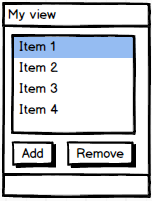SO, let's say that you have a nicely designed and unit tested class. Perhaps it's a MVVM dialog model which takes care of commands and displaying stuff. In the beginning, this class has a single list of selectable objects, a button which adds a new object and a button which removes objects:
Testing this is simple, isn't it? Create a test which verifies that the list has the relevant objects. Write another test which adds a new object and a third test which removes the selected object. Life is easy!
Now your client is so happy with the dialog, he has some additional requests. He wants to add some complex filtering so that only objects that meet certain criteria are visible. He also wants the list to be shown in a hierarchical tree instead of a flat list. Of course he also wants to define how to group them. Oh, and, based on the user's privileges, the remove functionality may or may not be enabled:
Now we have thrown a lot more logic into the dialog. There are multiple cases which yield a growing number of permutations -- how can we make sure that we cover all of those scenarios in tests? The user may or may not filter, he may or may not group into categories, etc. Your class is starting to get hard to test. It's turning into an untestable monster.
You will see this in your code. You will see it a lot. Well, it's a sign!
It's a sign
Testable code which turns into untestable code usually means that the code has a more fundamental problem. As a class grows, it is getting more and more responsibilities. More responsibilities means more scenarios to cover, and more complexity. The class is starting to violate The Single Responsibility Principle.Regardless of whether we do TDD or not, this is a bad thing. It's time to divide and conquer -- split your complex multi-responsibility class into smaller, simpler single-responsibility classes. Those classes will be easier to test, and you will avoid all the complex test scenario permutations.
Divide and conquer
In our view model example, the view model has at least these responsibilities:- Do filtering of items based on some criteria
- Organize the items into a hierarchy based on user selection
- Present the hierarchy as a tree view
- Allow user to select items
- Add and remove items
- Disable features based on user privileges
In this case, I would split the class up into a filter class, a hierarchy organizer class, user interaction handler, etc. This is a good idea anyway from a software quality perspective.
Conclusion
As classes grow with an increasing number of responsibilites, testing becomes harder. Don't get tempted to skip the tests. Instead, refactor the production code class so that it becomes testable AND well-designed.TDD is not only a first line of defense against new defects. It's also a very efficient design tool which forces you to keep your classes tidy and adhere to the SOLID principles.
Poor testability is a sign. Embrace the sign. Refactor your code today!




